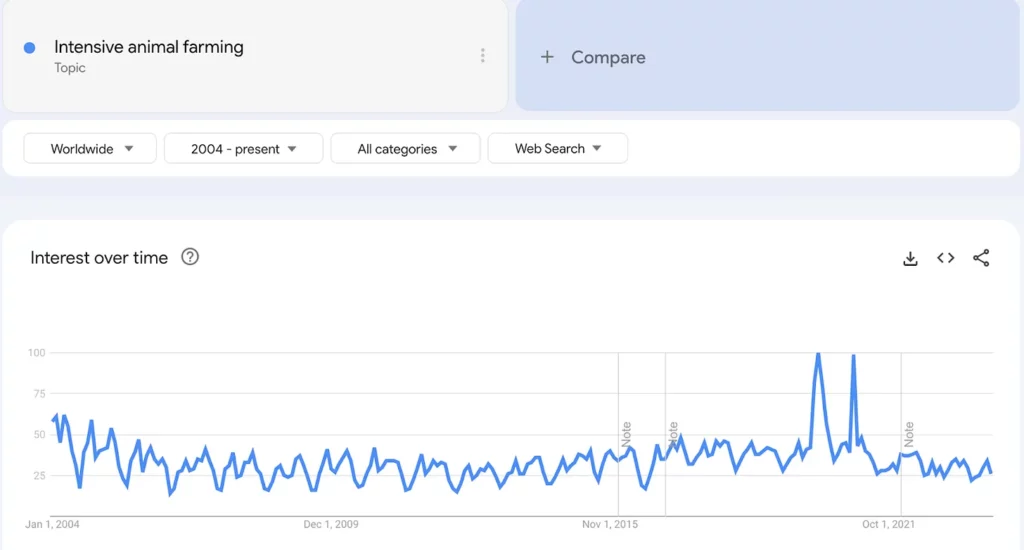This post originally appeared in the monthly farm animal welfare newsletter written by Lewis Bollard, program officer for farm animal welfare. Sign up here to receive an email each month with Lewis’ research and insights into farm animal advocacy. Note that the newsletter is not thoroughly vetted by other staff and does not necessarily represent consensus views of Open Philanthropy as a whole.
It’s easy to ignore factory farming. Inflation sparks public debates about the economy. Natural disasters spur news stories on climate change. Advances in artificial intelligence prompt discussion of its risks. But abuses on factory farms go ignored.
An analysis by my colleague Emma Buckland found that, since 2010, global English-language print and online news coverage of factory farming has only grown in line with other reporting on agriculture (see graph below). By contrast, coverage of climate change has grown two to three times faster. Google News lists 0.02 – 0.4% as many articles in the last week on factory farming as on climate change.
Undercover investigations once broke this media silence. In the decade up to 2018, top US media outlets, like CBS, CNN, and NBC, routinely covered their findings. Since then, they seldom have. Before 2018, 27 undercover investigations from the top three investigative groups surpassed 500,000 views on YouTube. Since then, none have.
This matters because factory farming thrives in the dark. Many industry practices are publicly indefensible, so the industry prefer to not publicly discuss them at all. And when the media ignores factory farming, politicians and corporate leaders can too.
A 2022 Faunalytics study tested the impact of various advocacy tactics on 2,405 people. News articles and social media posts most reduced self-reported animal product consumption and improved attitudes toward farm animal welfare. (Though the impact of all tactics was small.) They also didn’t trigger a backlash, as more confrontational tactics like disruptive protests did.

Why is factory farming so rarely publicly discussed? Some blame industry capture of the media. But the industry struggles to get news coverage too. The US chicken industry’s main communications initiative, Chicken Check-In, appears to have never secured a story in a mainstream news outlet or many “likes” on its social media posts. The problem is not media bias, but media indifference.
That indifference likely has many causes. Factory farming’s horrors aren’t new, so they’re not “news.” The topic is too obscure for most newspapers, too gruesome for most television shows, and too mundane for most online culture warriors. It doesn’t help that animals can’t speak, so they can’t squawk about their plight online.
The decline in coverage of undercover investigations is more mysterious. It may have to do with ag-gag laws, the collapse of investigative journalism, or the media’s obsession with US politics. But it may also be thanks to pink slime. ABC News’ reporting on that meat-derived goo ensnared it in a lawsuit, which led to a record defamation settlement of $177M in 2017. Soon afterward, media coverage of factory farm investigations began to decline.
The story on social media is even less clear. The algorithms likely changed, but we don’t know how or why. We may be victims of the social media giants’ 2016 post-election crack-down on distressing videos. Or the algorithms may just have mastered what people really want to watch — and the answer is kittens in a maze, not tortured chickens.
What can we do about this? I’m no PR expert, so I asked some movement leaders who are, plus a few friends in the media. They had lots of ideas — far too many to list here. So I focus below on some broad points of agreement across three areas: media, influencers, and narrative. (A disclaimer: this is a list of interesting ideas, not a list of things that Open Philanthropy is looking to fund. Like, really, please no pitches.)

Motivate the media
Despite the transformation of the media landscape, most Americans still get their news from television news and news websites. (Search and social media come next, but radio and newspapers aren’t far behind.) To get more media, movement leaders thought we should:
- Innovate. Our movement has innovated in the species we help and the countries we reach, but less in the tactics we use to get attention. Advocates suggested trying a host of new tactics — and, critically, setting up feedback loops to see if the tactics actually work in accelerating progress for animals.
- Provide credible data. Journalists need information they can rely on, and often lack the time to find it. Advocates can help by assembling statistics to show clear trends in factory farming, for example as Our World in Data has done.
- Focus on what’s new. An enduring moral atrocity is sadly not a news story. Journalists need a news “hook.” This could be a new study on animal sentience or animal agriculture’s climate impact; a new scandal about food safety or animal cruelty; or new events like factory farm fires or a legislative initiative.
- Take some risks. As our movement has professionalized, it’s gotten more cautious. This has led to a welcome reduction in Holocaust-themed campaigns. But it’s also sapped our appetite for risky activism, like calling out bad corporations, as advocates did for past PR wins like the McLibel case.
- Befriend a journalist. Our movement’s most successful PR specialists have built trusting relationships with journalists who report on food, agriculture, or climate. More advocates could proactively reach out to journalists to help them to find accurate information on our issues.
- Get professional help. For example, the Global Strategic Communications Council has brought together PR professionals passionate about climate change, who help climate leaders, academics, and think tanks to get positive press.
- Pitch stories. The best stories have protagonists, antagonists, and conflict. We have all three. For example, some popular recent stories have featured brave whistleblowers (VICE), meat industry apologists (The New York Times), and legislative battles (Vox).
Influence the influencers
A lot of influential people already agree with us — they just don’t talk about it much. A low-hanging fruit may be to help these influencers to engage their followers about factory farming. Movement leaders called out a few sets of influencers:
- Public intellectuals. Yuval Noah Harari calls factory farming “one of the worst crimes in history.” Jane Goodall, Peter Singer, Martha Nussbaum, Nicholas Kristof, and Rutger Bergman have all expressed similar sentiments. We could help them and others to write and speak more frequently about the topic.
- Podcast hosts. Ezra Klein calls our treatment of farm animals “a defining moral failing of our age,” #1 Spotify host Joe Rogan says it’s the “worst version of what human beings are capable of,” while Sam Harris labels it “a horror show.” We could pitch them on guests who could help them to cover the topic more.
- Hollywood stars. Natalie Portman and Joaquin Phoenix made documentaries about factory farming, while Sir Paul McCartney and Alec Baldwin narrated videos about it. A Hollywood bureau could engage them and screenwriters to get more content on factory farming into TV shows and movies.
- Dormant influencers. Oprah devoted an episode to factory farming, Martha Stewart made a video attacking it, and Ellen DeGeneres hosted a fundraiser to restrict it (that last one used to sound better). Yet none has talked about factory farming in almost a decade. We could do more to activate these past allies.
- Social media influencers. A horde of carnivorous influencers, like the Liver King and Carnivore Aurelius, have lately been hunting down plant-based meat online. Whether this is part of an ultra-processed meat industry master-plan or just an organic upsurge of primal instincts, it has largely gone unmatched. One idea is a hub to help sympathetic social media influencers share lessons and effective messages. Which brings us to…

Nurture the narrative
A common theme was that we need a better narrative. (I dunno: “meat is murder” and “dairy is scary” are pretty catchy.) Movement leaders had lots of ideas here:
- Talk about what we all agree on. Animal Think Tank’s research found that messaging beloved by some advocates — like talk of speciesism and oppression — turned off the general public, as did proposals to tax meat or subsidize plant-based agriculture. By contrast, messaging about animal sentience and welfare enjoyed over 85% agreement, and even a proposal to ban factory farming got 49% support — as it has in past surveys.
- Keep it positive and solutions-focused where possible. PaxFauna’s research found the most common reason for dismissing our message was futility — people felt hopeless against the scale of factory farming. Advocates can highlight wins and solutions. This also fits with the focus of the news media and social media algorithms, which both increasingly favor positive stories.
- Explain, don’t assume. Most Americans still think farm animals are treated well. Two of the most popular recent YouTube videos on factory farming are explainers from Animals Australia on chicken slaughter (7.2M views) and chick killing (2.1M views). Both feature graphic footage, but couch it in a factual explanation of what’s going on.
- Connect factory farming to other issues — and focus on the animals. Some leaders felt strongly that we should focus on health and the environment to get more media. Others felt strongly that we should focus on the animals to ensure the media we get leads to reforms for animals, and not just, for example, a switch from beef to chicken. I’m conflict-averse, so I’ll split the difference: perhaps we can both connect to other issues and keep animals central in the resulting stories.
- Focus on social change, not just diets. Much of our movement’s social media messaging just exhorts people to “go vegan.” This risks reducing a major social issue to a question of personal diets. Both Animal Think Tank and PaxFauna suggest we start engaging people less as consumers and more as citizens, who can support political and corporate change.
After I wrote the above, I took a moment to reflect on the success our movement has had in this domain. It’s impressive: we’ve successfully framed the issue publicly as “factory farming” (an accurate term, but not the one favored by industry) and won the moral debate (few people now defend factory farming as ethical; its few defenders argue largely on economic grounds). I’m confident that our movement is up to the next challenge — to make this an issue that society can no longer ignore.
